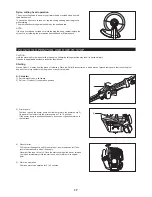
14
,QVSHFWLRQDQGUH¿OORIHQJLQHRLO
– Perform the following procedure, with the engine cooled down.
– Set the engine level, remove oil cap (Fig. 1), and check to see whether or not there is oil in the range between the upper limit and lower limit
marks of the oil pipe (Fig. 2).
± 7RSXSZLWKRLOWRXSSHUOLPLWPDUNLIRLOLVLQVXI¿FLHQWRLOOHYHOLVFORVHWRORZHUOLPLWPDUN)LJ
– The area surrounding the external marks is transparent, so the amount of oil inside can be checked without having to remove the oil cap.
However, if oil pipe becomes extremely dirty, visibility may be lost, and oil level will have to be checked against stepped section on inside of
oil pipe.
± )RUUHIHUHQFHWKHRLOUH¿OOWLPHLVDERXWKWLPHVRUWDQNVRIRLOUH¿OO
If the oil changes in color or mixes with dirt, replace it with new one. (For the interval and method of replacement, refer to P 20)
Recommended oil:
6$(:RLORI$3,&ODVVL¿FDWLRQ&ODVV6)RUKLJKHUVWURNHHQJLQHIRUDXWRPRELOH
Oil volume:
Approx.
0.08L
1RWH,IWKHHQJLQHLVQRWNHSWXSULJKWRLOPD\JRLQWRDURXQGWKHHQJLQHDQGPD\EHUH¿OOHGH[FHVVLYHO\
,IWKHRLOLV¿OOHGDERYHWKHOLPLWWKHRLOPD\EHFRQWDPLQDWHGRUPD\FDWFK¿UHZLWKZKLWHVPRNH
Point 1 in Replacement of oil: “Oil gauge”
± 5HPRYHGXVWRUGLUWQHDUWKHRLOUH¿OOSRUWDQGGHWDFKWKHRLOJDXJH
– Keep the detached oil gauge free of sand or dust. Otherwise, any sand or dust adhering to the oil gauge may cause irregular oil
circulation or wear on the engine parts, which will result in troubles.
Fig. 1
Fig. 2 Oil pipe
Fig. 3
BEFORE START OF OPERATION
(1) Keep the engine level, and detach the oil cap.
(2) Fill with oil to upper limit mark. (see Fig. 3)
8VHRLOERWWOHZKHQ¿OOLQJ
6HFXUHO\WLJKWHQWKHRLOFDS,QVXI¿FLHQWWLJKWHQLQJPD\FDXVHRLOOHDNDJH
Oil cap
Oil pipe
Internal stepped
section (upper
limit)
External mark
(lower limit)
Internal stepped
section (lower
limit)
External mark
(upper limit)
Oil
Top up with oil until
oil level reaches
internal stepped
section (upper
limit).
The area between the
external upper and lower
limits is transparent, so
oil level can be checked
externally against these
marks.















































